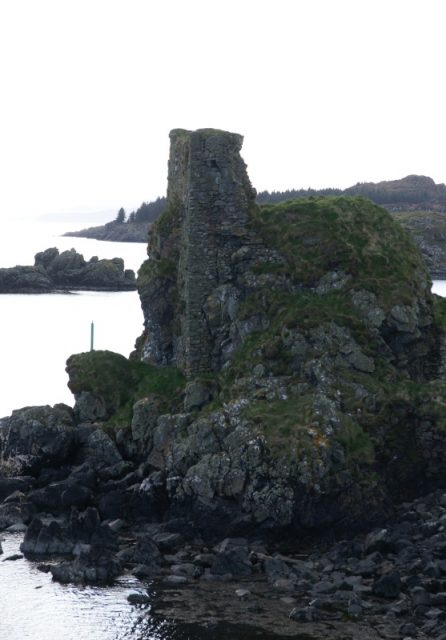The conflicts between clans in 16th and 17th century Scotland are famous, and one that raged between the Campbell family and the MacDonald family was particularly unrelenting.
Now a seal owned by one of the clan leaders, Sir John Campbell of Cawdor, has come to light. It was buried beneath mounds of rubble at Dunyvaig Castle on Islay, where the clans fought.
Islay is the southernmost of the Inner Hebrides islands, off the west coast of Scotland, and is celebrated today for its whisky. In fact, Islay is known as “The Queen of the Hebrides” and celebrated as the reigning monarch of a typically smoky, peaty style of single malt whisky. Its 17th century history was considerably more tumultuous.
The artifact that attests to the conflict was described as “remarkable” and “extremely rare” by archaeologists.
Once used to sign and seal charters and documents, the seal is a disc of lead that carries the inscription “Ioannis Campbell de Calder.” (Calder was the original spelling of Cawdor). It carries the Cawdor coat of arms with a galley ship and a stag and is dated 1593.
The Campbells and the MacDonald’s fought over Dunyvaig in the early 17th century, with a series of sieges of the castle until the Campbells won. Sir John took ownership of Islay in 1615.
 |
| A field school student has unearthed the seal of Sir John Campbell of Cawdor, a leader of the Campbell clan. Photo by Islay Heritage and the University of Reading |
Losing the castle was a bitter blow for the MacDonalds. The castle was once the naval fortress of the Lords of the Isles, the chiefs of the clan MacDonald. Most of the castle remains are from the 16th century but the foundations are believed to be centuries older.
The seal was found by a field student during an excavation of the castle being carried out by Islay Heritage and the University of Reading. According to the BBC, University of Reading student Zoë Wiacek, who found the seal, said everyone on the dig became excited when it was uncovered.
She said: “I removed a piece of rubble and it was just sitting there on the ground. I immediately knew it was an important find, but had no idea what it was. I called over my trench supervisor, and when it was lifted, the soil fell away to show the inscription.”
The clan feud was a bitter one and long lasting, with much blood spilled.
The website Memories of Scotland says, “Memories run long in the highlands of Scotland and, we've heard tell, the bitterness between Clans Campbell and MacDonald continues to this day. The clash between these two ancient Celtic houses, which has lasted for hundreds of years, is not just about lands, religion, Jacobitism, or even betrayal. Rather, it is about power.”
In 1344, the chief of the MacDonalds began to style himself “Lord of the Isles.” Each of the succeeding Lords of the Isles rebelled against their Stewart king, often in coordination with the English kings.
 |
| Dunyvaig Castle, Islay, Scotland. Seen from northeast. Photo by Otter CC BY-SA 3.0 |
Said Memories of Scotland, “They sought an independent Highland kingdom and bitterly resented paying fealty to lowland Scots. They had been kings and wished to be kings still. Yet, they were completely unsuccessful and there were only four acknowledged Lords of the Isles.”
The Campbells, however, sought power in Scotland while cooperating with the Stewart kings, and they were the ones who tried to take down the MacDonalds.
“The Campbell lands lie in Argyll. By the 16th century, the chiefs were Earls of Argyll, and these days (and for some time past) there has been a Duke of Argyll, the 9th of whom married a daughter of Queen Victoria.”
As the clan with the muscle in that part of Scotland, the Campbells were all too ready to besiege the castle on Islay and try to dislodge the MacDonalds. After they won, there was of course considerable bitterness.
The most notorious chapter in the clans' feud was the Massacre of Glencoe in 1692. The Campbells, now loyal to the British Crown, held by William of Orange, instead of the Stuarts and their Jacobite cause, initiated an underhand and savage attack against the MacDonalds. Their soldiers killed the chief of the clan, 33 other men, two women, and two children.
The massacre took place after the Campbells and their followers were welcomed by the MacDonalds for two weeks of Celtic hospitality. The Campbells had pretended to come as friends. But in the dark early morning of February 13, 1692, the guests slaughtered their unarmed hosts, not even sparing the children.
The horror of the Glencoe Massacre is thought to have inspired George R. R. Martin in his “Red Wedding” section of Game of Thrones, in which one family is wiped out under the guise of hospitality.
-------------------------------------------------------------
Nancy Bilyeau is the author of the 18th century-set novel 'The Blue,' featuring a Huguenot artist who goes undercover to spy in a porcelain factory. The novel was published on Dec. 3, 2018, in the US, the UK, Australia and Canada. Publishers Weekly said, "Historical fans will be well satisfied."
No comments:
Post a Comment